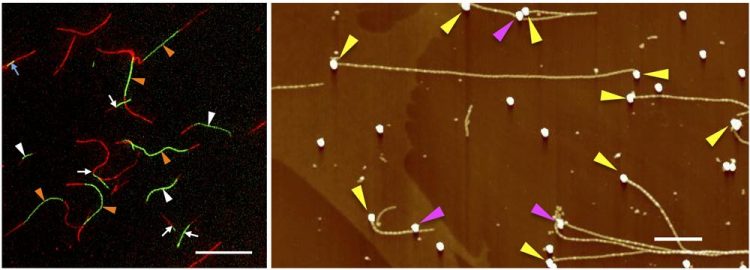A versatile method to pattern functionalized nanowires

(Left) Growth of tandem fluorescent fibrils. Scale bar = 20 micrometers. (Right) Fibrils extended from gold nanoparticles placed on the surface of a substrate. Scale bar = 1 micrometer.
There has been considerable interest worldwide in the patterning of functionalized nanowires—which excel both in semiconductivity and as catalyzers—due to the potential application of such materials in nanodevice construction. Establishing a versatile approach to make functionalized nanowires, with a particular need to controlling spatial patterning, has been seen as essential.
The team, led by Professor Kazuyasu Sakaguchi of the Faculty of Science’s Department of Chemistry, had previously developed an effective method, named structure-controllable amyloid peptides (SCAPs), to control self-assembly of amyloid peptides, which are the building blocks of nanowires and also known as the causative molecule for Alzheimer’s disease.
In the latest research, the team combined the SCAPs with templated fibril growth—a distinctive quality of amyloid peptides—and succeeded in the formation of nanowires with tandem domain structures or a single nanowire extending from a specific starting point.
To create the tandem structure, the SCAPs method was used to make initial amyloid fibrils—marked by green fluorescence—which were used as a template, and to allow another type of amyloid peptide—marked by red fluorescence—extend from the starting fibrils.
Analysis showed a 67% tandem yield, three times higher than the efficiency yield of previous studies. Moreover, a few geometrical patterns could be discerned in the tandem structures, the proportion of which could be controlled by adjusting the peptide mix ratio.
Furthermore, by attaching template fibrils to gold nanoparticles placed on substrate surface through molecular recognition, then allowing new fibrils to extend from the template, the researchers succeeded in forming a single nanowire in a specific location. Achieving this kind of advanced pattern control is a world-first.
This method is applicable to the self-assembly of nanowires for nanoelectrodes created by lithography. “It could also be used to prepare a wide variety of fibril patterns and hence open up new avenues for the development of novel self-assembled nanodevices,” Professor Sakaguchi said.
Contacts:
Professor Kazuyasu Sakaguchi
Department of Chemistry, Faculty of Science
Hokkaido University
kazuyasu[at]sci.hokudai.ac.jp
http://wwwchem.sci.hokudai.ac.jp/~biochem/english/index.html
Naoki Namba (Media Officer)
Global Relations Office
Office of International Affairs
Hokkaido University
pr[at]oia.hokudai.ac.jp
Tel: +81-11-706-8034
Associated links
Journal information
Sakai H. et al., Patterning nanofibrils through the templated growth of multiple modified amyloid peptides, Scientific Reports, August 25, 2016. DOI: 10.1038/srep31993
Funding information
This work was supported in part by a Grant-in-Aid for Scientific Research (B) (No. 24310152) from the Japan Society for the Promotion of Science (JSPS) (to K.S.), as well as a Research Fellowship from the JSPS for Young Scientists (No. 23-7100) (to H.S.).
Media Contact
More Information:
http://www.researchsea.comAll latest news from the category: Life Sciences and Chemistry
Articles and reports from the Life Sciences and chemistry area deal with applied and basic research into modern biology, chemistry and human medicine.
Valuable information can be found on a range of life sciences fields including bacteriology, biochemistry, bionics, bioinformatics, biophysics, biotechnology, genetics, geobotany, human biology, marine biology, microbiology, molecular biology, cellular biology, zoology, bioinorganic chemistry, microchemistry and environmental chemistry.
Newest articles

Machine learning algorithm reveals long-theorized glass phase in crystal
Scientists have found evidence of an elusive, glassy phase of matter that emerges when a crystal’s perfect internal pattern is disrupted. X-ray technology and machine learning converge to shed light…

Mapping plant functional diversity from space
HKU ecologists revolutionize ecosystem monitoring with novel field-satellite integration. An international team of researchers, led by Professor Jin WU from the School of Biological Sciences at The University of Hong…

Inverters with constant full load capability
…enable an increase in the performance of electric drives. Overheating components significantly limit the performance of drivetrains in electric vehicles. Inverters in particular are subject to a high thermal load,…





















